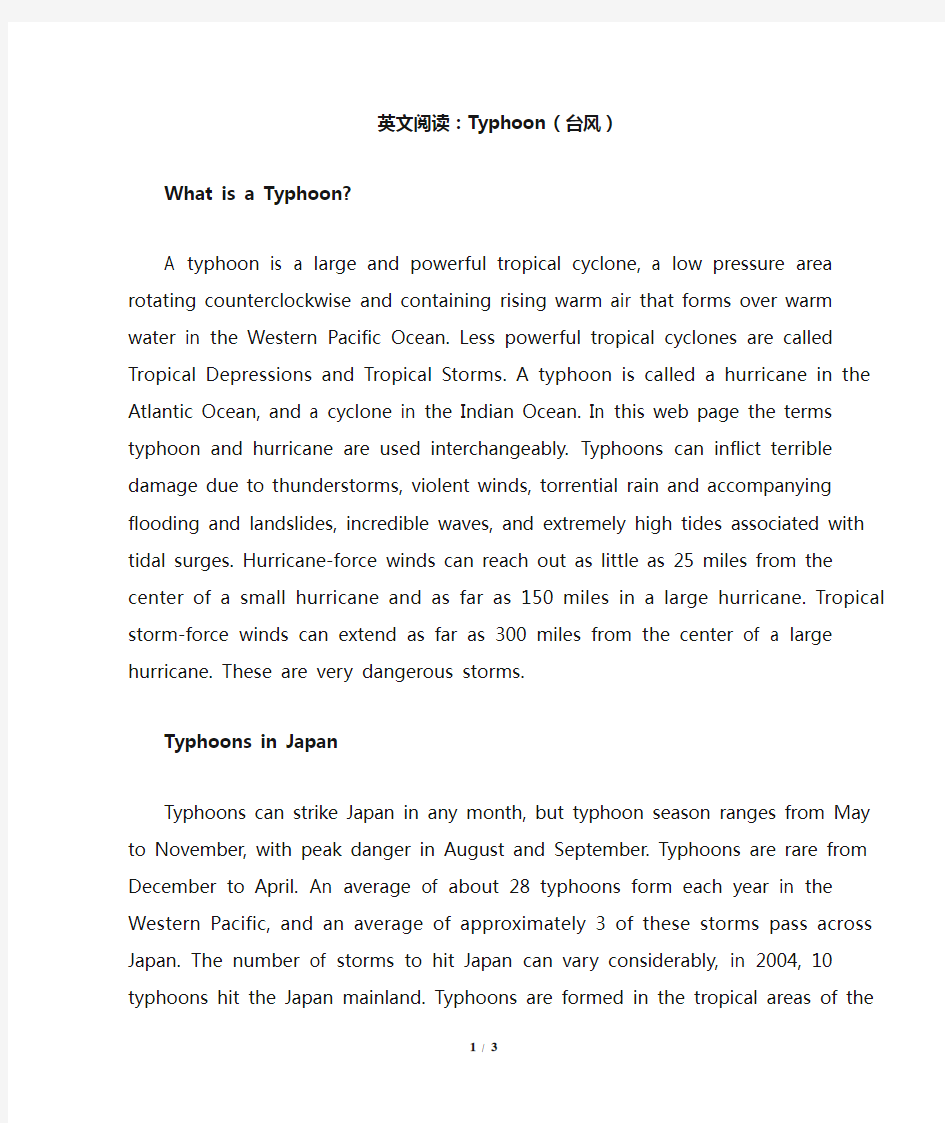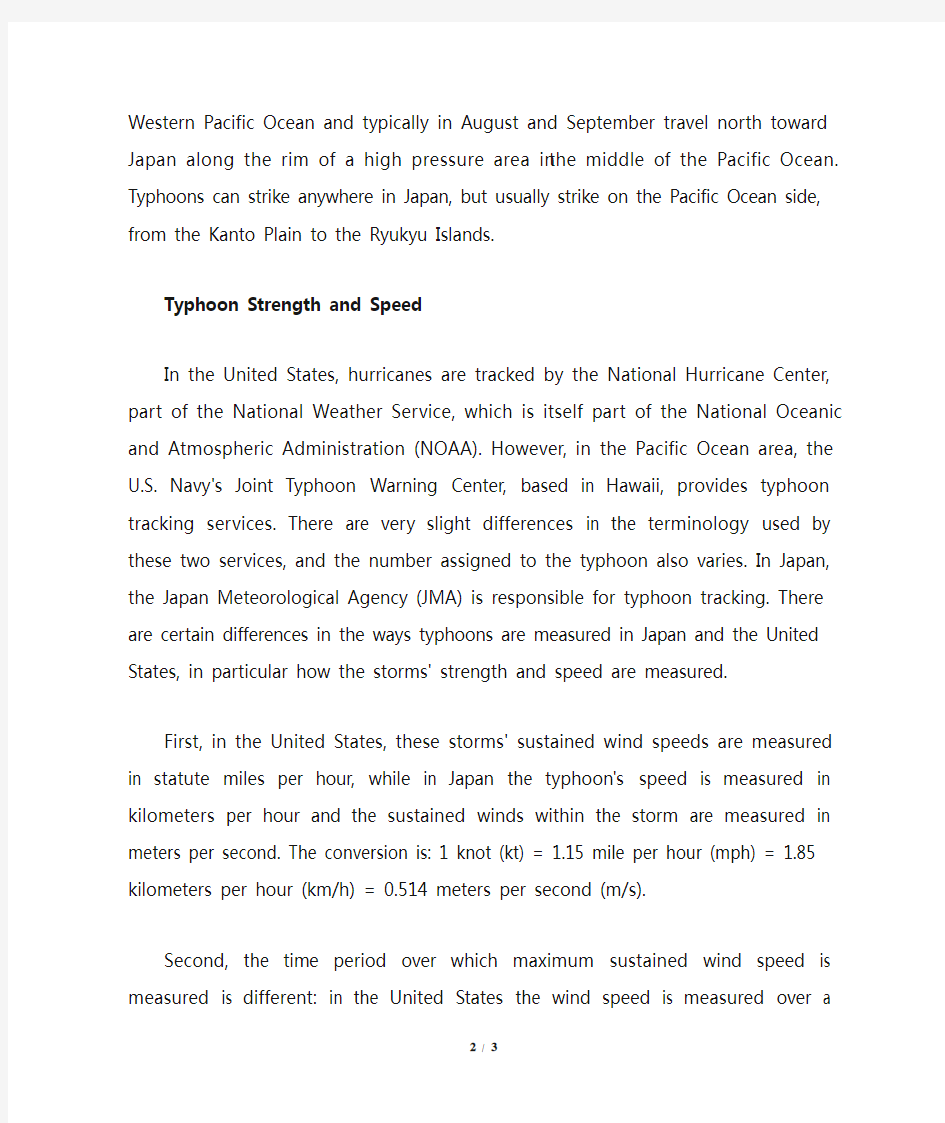英文阅读:Typhoon(台风)


英文阅读:Typhoon(台风)
What is a Typhoon?
A typhoon is a large and powerful tropical cyclone, a low pressure area rotating counterclockwise and containing rising warm air that forms over warm water in the Western Pacific Ocean. Less powerful tropical cyclones are called Tropical Depressions and Tropical Storms. A typhoon is called a hurricane in the Atlantic Ocean, and a cyclone in the Indian Ocean. In this web page the terms typhoon and hurricane are used interchangeably. Typhoons can inflict terrible damage due to thunderstorms, violent winds, torrential rain and accompanying flooding and landslides, incredible waves, and extremely high tides associated with tidal surges. Hurricane-force winds can reach out as little as 25 miles from the center of a small hurricane and as far as 150 miles in a large hurricane. Tropical storm-force winds can extend as far as 300 miles from the center of a large hurricane. These are very dangerous storms.
Typhoons in Japan
Typhoons can strike Japan in any month, but typhoon season ranges from May to November, with peak danger in August and September. Typhoons are rare from December to April. An average of about 28 typhoons form each year in the Western Pacific, and an average of approximately 3 of these storms pass across Japan. The number of storms to hit Japan can vary considerably, in 2004, 10 typhoons hit the Japan mainland. Typhoons are formed in the tropical areas of the Western Pacific Ocean and typically in August and September travel north toward Japan along the rim of a high pressure area in the middle of the Pacific Ocean. Typhoons can strike anywhere in Japan, but usually strike on the Pacific Ocean side, from the Kanto Plain to the Ryukyu Islands.
Typhoon Strength and Speed
In the United States, hurricanes are tracked by the National Hurricane Center, part of the National Weather Service, which is itself part of the National Oceanic and Atmospheric Administration (NOAA). However, in the Pacific Ocean area, the U.S. Navy's Joint Typhoon Warning Center, based in Hawaii, provides typhoon tracking
services. There are very slight differences in the terminology used by these two services, and the number assigned to the typhoon also varies. In Japan, the Japan Meteorological Agency (JMA) is responsible for typhoon tracking. There are certain differences in the ways typhoons are measured in Japan and the United States, in particular how the storms' strength and speed are measured.
First, in the United States, these storms' sustained wind speeds are measured in statute miles per hour, while in Japan the typhoon's speed is measured in kilometers per hour and the sustained winds within the storm are measured in meters per second. The conversion is: 1 knot (kt) = 1.15 mile per hour (mph) = 1.85 kilometers per hour (km/h) = 0.514 meters per second (m/s).
Second, the time period over which maximum sustained wind speed is measured is different: in the United States the wind speed is measured over a one-minute period, in Japan it is measured over a ten-minute period. In practice, this means that the same storm will show lower wind speeds in Japan and higher wind speeds in the United States. Put differently, to an American this means that a typhoon in Japan with winds of a given speed will be more destructive than would be expected for a storm of that size. Note that gusts of wind are not factored into the sustained wind speed, and these gusts' speeds can be 20% or even higher than the speed of the sustained winds.
Because of these differences, we have placed each system on a separate chart to reduce confusion. We recommend that viewers refer to both charts. The chart labeled United States System of Hurricane Classification is an amalgamation of the National Hurricane Center, Joint Typhoon Warning Center, and other classification systems. Finally, Japan also classifies the scale of the typhoon, that is the radius of the area in which the wind speed is over 15 meters per second. The United States does not use this classification system. The Joint Typhoon Warning center updates its information every six hours, while the Japan Meteorological Agency updates its information every three hours, and every hour upon a storm's approach to Japan.
